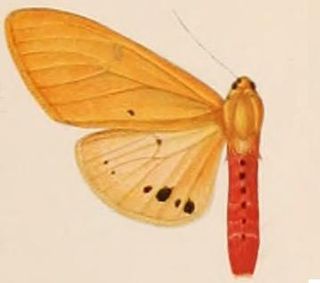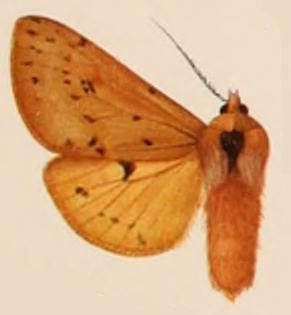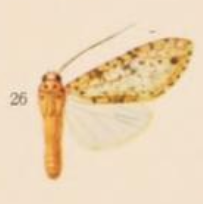
Spilosoma eldorado is a moth of the family Erebidae. It was described by Walter Rothschild in 1910. It is found in eastern India and Sri Lanka.

Spilosoma fraterna is a moth of the family Erebidae first described by Walter Rothschild in 1910. It is found on Papua New Guinea.

Lophocampa endrolepia is a moth of the family Erebidae. It was described by Paul Dognin in 1908. It is found in Ecuador.
Choristostigma erubescens is a moth in the family Crambidae. It was described by George Hampson in 1899. It is found in Xalapa, Mexico.
Tabidia strigiferalis is a moth in the family Crambidae. It is found in China, Korea and Russia.
Tabidia obvia is a moth in the family Crambidae. It was first described by Xi-Cui Du and Hou-Hun Li in 2014. It is found in China in Gansu, Hubei, Chongqing, Sichuan, Guizhou, Zhejiang and Guangdong.
Haritalodes polycymalis is a moth in the family Crambidae. It was described by George Hampson in 1912. It is found in the Democratic Republic of the Congo, Guinea, Ivory Coast, Kenya, Madagascar, Malawi, Mozambique, Sierra Leone, South Africa (KwaZulu-Natal), Tanzania and Uganda.
Pilocrocis fulviflavalis is a moth in the family Crambidae. It was described by George Hampson in 1917. It is found in Peru.
Polygrammodes hyalescens is a moth in the family Crambidae. It was described by George Hampson in 1913. It is found in Peru.
Polygrammodes sanguifrons is a moth in the family Crambidae. It was described by George Hampson in 1913. It is found in Peru.
Polygrammodes semirufa is a moth in the family Crambidae. It was described by George Hampson in 1913. It is found in São Paulo, Brazil.
Sufetula pygmaea is a moth in the family Crambidae. It was described by George Hampson in 1912. It is found in Mexico.
Syllepte microdontalis is a moth in the family Crambidae. It was described by George Hampson in 1912. It is found in French Guiana.
Syllepte xylocraspis is a moth in the family Crambidae. It was described by George Hampson in 1912. It is found in South Africa.
Syllepte diacymalis is a moth in the family Crambidae. It was described by George Hampson in 1912. It is found in Mexico (Morelos), Guatemala and Costa Rica.
Tylostega tylostegalis is a moth in the family Crambidae. It was described by George Hampson in 1900. It is found in the Russian Far East and western China.
Udeoides nigribasalis is a moth in the family Crambidae. It was described by George Hampson in 1913. It is found in Kenya.
Ambia cymophoralis is a moth in the family Crambidae described by George Hampson in 1917. It is found on St Aignan Island in the Louisiade Archipelago of Papua New Guinea.
Ambia fulvicolor is a moth in the family Crambidae. It was described by George Hampson in 1917 and it is found in New Guinea.
Sesquiluna albilunata is a moth in the family Endromidae first described by George Hampson in 1910. It is found in Assam, India.

